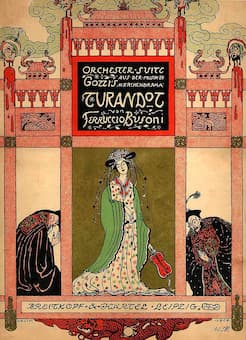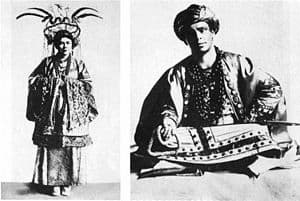
Busoni: Turandot Suite Score Cover
Ferruccio Busoni (1866-1924) famously claimed that Schiller’s translation of Carlo Gozzi’s dramatic fairy-tale Turandot in conjunction with Carl Maria von Weber’s incidental music “ruined a masterpiece of Italian literature.” With the centennial of Gozzi’s death on the horizon in 1906, Busoni set to work on his own incidental music for the play. Busoni writes, “the task absorbed me completely for two and half months, during which I was unable to concentrate on anything else.” During this period in the early autumn of 1905, Busoni chronologically worked through the play and composed music for those places where Gozzi had explicitly called for it, or “wherever his theatrical instincts suggested it could enhance the drama.” In all, Busoni sketched thirteen musical numbers for the play and orchestrated them immediately.
Ferruccio Busoni: Turandot Suite (Hong Kong Philharmonic Orchestra; Samuel Wong, cond.)

Gozzi’s Turandot: Gertud Eysoldt as Turandot; Alexander Moissi as Calaf
For his melodic materials, Busoni relied on a publication by the distinguished critic and historian August Ambros. In his History of Music, Ambros illustrated the early developments of non-European music, citing Chinese, Arabic, Byzantine, Indian and Nubian themes. Ambros’ supposed cultural links resonated deeply with Busoni’s own theories of melody, “since the myriad strains that once shall sound have existed since the beginning.” Curiously, Busoni also quoted “Greensleeves” in an arrangement for two flutes and two harps. While it is possible that Busoni was unaware of the English origins of that melody, it is more likely that he saw the tune in a famous manuscript during his visit to Trinity College in Dublin in 1903. Significantly, in the 16th century, this tune was originally connected with public executions. Given that powerful symbolism, it is hardly surprising that this tune becomes connected with the character of Turandot. Please also note that the cover art connected with the first publication of the Turandot Suite features the princess in a garment sporting “green sleeves.” First performed as a concert piece in 1905, the Turandot Suite underwent a number of revisions. In 1911 Max Reinhardt staged a production of the play in a new translation by the young and dynamic writer Karl Vollmöller, and Busoni’s incidental music became an integral part of the performance at the Deutsches Theater in Berlin. It would take Busoni a further six years, however, before he had transformed his Turandot Suite into an opera.
For more of the best in classical music, sign up to our E-Newsletter

